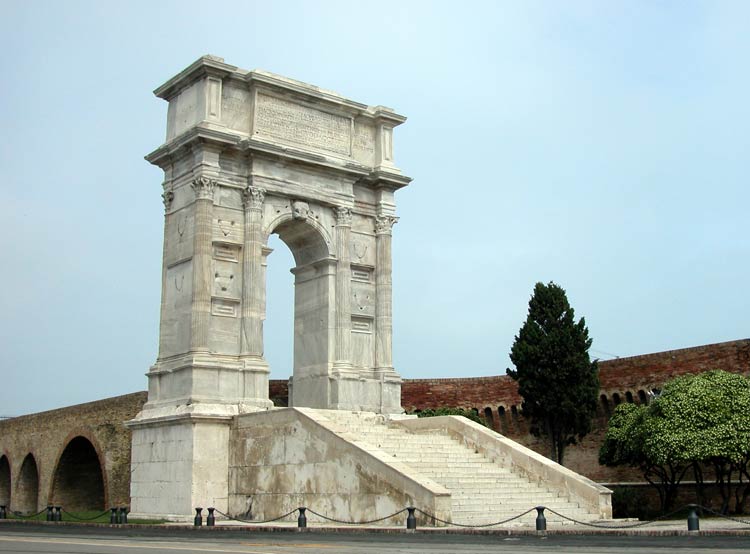PLACES TO VISIT TO ANCONA - POSTI DA VISITARE AD ANCONA
-THE
TRAJAN’S ARCH
The
Trajan's Arch in Ancona is a Roman Triumphal arch erected by Senate
and people of Rome in the reign of Emperor Trajan. It was built in
honor of Emperor after he expanded the port of the city out of his
pocket, improving the docks and the fortifications. Trajan departed here for the latest successful war against the Dacian.
L'
Arco di Traiano è un arco romano trionfale eretto dal Senato e dal
popolo di Roma durante il regno dell' imperatore Traiano. E' stato
costruito in onore dell' imperatore dopo aver ampliato il porto della
città di tasca sua, migliorando le banchine e le fortificazioni. Traiano partì da qui per l' ultima guerra di successo contro i
Daci.
-LAZZARETTO
The
Lazzaretto, also called the Mole Vanvitelliana, is a 18th-century
building constructed on an artificial island for the purpose of
saving as quarantine station and leprosarium for our city. A well was
located in the central Neoclassical tempietto dedicated to Saint
Roch, patron of lepers, in the center of the courtyard.
Il
Lazzaretto chiamato anche Mole Vanvitelliana, è un palazzo del 18°
secolo, costruito su un isola artificiale per lo scopo di salvare
come centro di quarantena e lebbrosario per la nostra città. Un
pozzo è collocato al centro del tempietto Neoclassico dedicato a San
Rocco, protettore dei lebbrosi, al centro del cortile.
-ANCONA CATHEDRAL
Ancona
Cathedral is a Romanesque Catholic Cathedral dedicated to Saint
Cyriacus. The building is an example of mixed Romanesque-Byzantine
and Gothic elements, and stands on the site of the former acropolis
of the Greek city, the Guasco hill which overlooks Ancona and it’s
gulf.
La
Cattedrale di Ancona è una Cattedrale cattolica romana dedicata a
San Ciriaco. L' edificio è un esempio di unione di elementi di stile
Romano - Bizantino e Gotico, e sorge sul sito di una ex acropoli
Greca, il colle Guasco che domina Ancona e il suo golfo.
-MERCHANT’S LODGE
The
palace was built in 1442 by architect Giovanni Pace, an economically
flourishing period for Ancona. It was the trade point of the
mercantile republic in medieval times, in order to provide a meeting
point for the traders.
Il
palazzo ècostruito nel 1442 dall' architetto Giovanni Pace, in
un periodo economicamente florido per Ancona. Era il punto
commerciale della repubblica nell' epoca Medievale, al fine di
fornire un punto di incontro per i commerci.
-THE WAR MEMORIAL
The
War Memorial of the First World War is located in Piazza IV Novembre,
in the Passetto. It was designed in the Twenties by Guido Cirilli in
the form of a circular temple of Doric style.
Il
Monumento ai Caduti della Prima Guerra Mondiale si trova in Piazza IV
Novembre nel Passetto. E' stato progettato negli anni Venti da Guido
Cirilli nella forma di un tempio circolare di stile Dorico.
-SANTA MARIA DELLA PIAZZA
The
church, a fine example of Romanesque architecture in the city, was
erected between the 11th and 12th centuries. Before its construction,
the site was home to two small Palaeo-Christian churches, dating to
6th and 7th centuries. Part of the current pavement of the church is in
glass to allow visibility to the remains of the latter.
La
chiesa, bell' esempio di architettura Romana nella città, fu eretta
tra il 11° e 12° secolo. Prima di questa costruzione, il sito era
sede di due piccole chiese Paleo - Cristiane, datate tra il 6° e il
7° secolo. Parte della pavimentazione della chiesa attuale è in
vetro per consentire la visibilità dei resti di quella precedente .
-THE ROMAN AMPHITEATER
The
Roman amphitheater of Ancona, is located on the hills Guasco and
Cappuccini. Its construction began during August time towards the end of the first century BC; then modified during the
period of Trajan ( first century AD- second century AD)
L'
Anfiteatro Romano di Ancona, si trova sul colle Guasco e Cappuccini.
La sua costruzione iniziò durante il periodo di Augusto verso la
fine del I secolo a.c.; poi modificato durante il periodo di Traiano
( I secolo d.c. - II secolo d.c)
Made by Sarah Becchetti &
Margherita Grilli
Made by Sarah Becchetti &
Margherita Grilli







Nessun commento:
Posta un commento